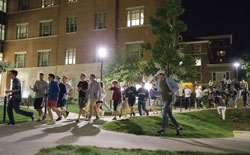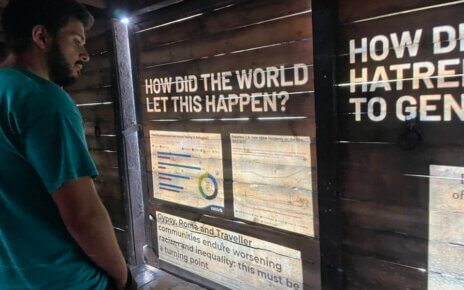What can only be described as a bad scene from an overrated horror film has begun taking the stage in neighborhoods throughout the U.S., causing commotion and resurfacing childhood fears for many. Clowns are sweeping the nation and causing mass hysteria for concerned parents, college campuses and those with a fear of clowns.
Menacing clowns have been terrorizing the streets in dozens of cities throughout the past couple of weeks, and as Halloween approaches, this frenzy has skyrocketed.
While this phenomenon seems to have ignited overnight, the clown that started this national craze was from Greenville, SC as he gained the presses attention trying to lure a child into the woods. The buzz this unsettling story created led to many following in the footsteps of the South Carolina predator, with hopes to get their own sixty seconds of fame.
Claude Taylor, professor of communication and transformative learning, shared his opinion on how this bizarre incident snowballed into a nationwide trend. “Sometimes what happens with contagions like this one, is that people see something on TV that gets attention and they want to emulate it themselves,” Taylor explained. “For me, what I’m seeing is an extension of the prank phenomenon where people want to get in on a rush. Teenagers are tired of watching others do it online, and want to up the ante and do it for themselves. Unfortunately, people are not thinking about the consequences of their actions in the heat of this trend, and its extraordinarily dangerous.”
The frequent clown sightings have instilled such a strong fear in college students that pepper spray sales have gone through the roof, and many are ready to fight back. With clowns roaming the streets at night, some residential college students are taking precautions to a whole new level. Penn State University recently bombarded the streets on a “clown hunt” in hopes to scare away the clowns seen on their campus.
With many on the defense in the heat of this clown craze, Monmouth University Director and Chief of Police Bill McElrath commented, “This is a craze that will probably die down after Halloween, and I wish to remind everyone that wearing a costume is not a crime.” Offering his advice on what to do when encountering one, McElrath said, “I am not aware of any clown sightings on campus, however, if someone in a clown suit was doing something inappropriate or suspicious, call the police.”
While freedom of expression is not a crime, police have taken action to those dressed in these colorful garbs on the grounds of harassment and “terroristic threats.” Dozens of pranksters have been arrested in these clown-related crimes while many sightings were proven to be false.
While the hysteria caused by clowns is a real concern and could potentially be a threat to safety, some college students are taking a more rational viewpoint on these occurrences. Senior business student Stephanie Merlis explained her take on the clown craze, “I think the clowns in this area are probably teenagers or college kids trying to scare other people that they’re friends with as a joke. It’s good for people to be aware of their surroundings and carry pepper spray, but I’m not worried about it too much.”
Throughout the West Long Branch community, many claimed they have encountered a clown and reported so to local authorities. Students living off campus have been the most startled by the recent sightings as living on your own stirs up all sorts of concerns, and with clowns in the mix its hit a whole new level.
Junior health studies student Caitlin Smoler shared her experience with the clown phenomenon. “Personally, I am petrified of clowns and I think the cops need to take more action, because it seems to be turning into a huge issue in this country,” Smoler explained. “There was one by my house [when] I wasn’t home, but my housemate texted me to tell me. Basically he was singing and pacing up and down the side of our house.”
It’s safe to say that this generation’s future children won’t be having clowns attend their birthday parties. But what does this current chaos do for the professional clown community? In a way, it dehumanizes those who make a living in this field, bringing laughter and joy to young children celebrating the coming of a new age.
Twitter accounts have been created to expose clowns who make appearances in the night, giving birthday party entertainers a bad name. This trend has even affected local government authorities to take action and ban clown costumes for the upcoming Halloween season. Although this fad has swept the nation, the implications were no more severe than startled citizens. The clown related death count is standing firm at zero as pranksters and false sightings are causing most of this commotion.
The underlying cause of this hysteria is the fictitious concept of clowns themselves. Clowns, regardless good or bad, are nothing more than people hiding under masks or makeup. The commotion with the recent sightings steams from the unknown about the people themselves. No one knows what is beneath the makeup, who the person is or what their motives are. This fear of the unknown has fueled this pandemonium and created one of the most bizarre trends this nation has ever seen.
IMAGE TAKEN from collegian.psu.edu




